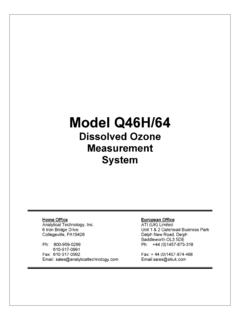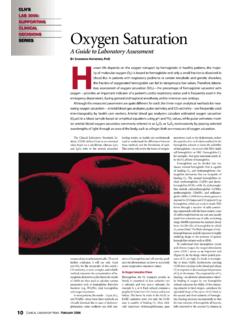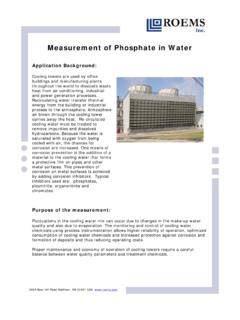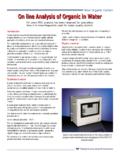Transcription of FUNDAMENTALS OF ORP MEASUREMENT
1 WHAT IS ORP?ORP stands for oxidation-reduction potential, which isa measure, in millivolts, of the tendency of a chemicalsubstance to oxidize or reduce another chemical is the loss of electrons by an atom, mole-cule, or ion. It may or may not be accompanied bythe addition of oxygen, which is the origin of the examples are iron rusting and wood a substance has been oxidized, its oxidationstate increases. Many substances can exist in anumber of oxidation states. A good example is sulfur,which can exhibit oxidation states of -2 (H2S); 0 (S);+4 (SO2); and +6 (SO4-2). Substances with multipleoxidation states can be sequentially oxidized from oneoxidation state to the next higher. Adjacent oxidationstates of a particular substance are referred to asredox couples. In the case below, the redox couple isFe+2/Fe:Fe = Fe+2+2e- iron ferrous ion electrons The chemical equation shown above is called thehalf-reactionfor the oxidation, because, as will beseen, the electrons lost by the iron atom cannot existin solution and have to be accepted by another sub-stance in solution.
2 So the complete reaction involvingthe oxidation of iron will have to include another sub-stance, which will be reduced. The oxidation reactionshown for iron is, therefore, only half of the total reac-tion that takes is the net gain of electrons by an atom,molecule, or ion. When a chemical substance is reduced, its oxidationstate is lowered. As was the case with oxidation, sub-stances that can exhibit multiple oxidation states canalso be sequentially reduced from one oxidation stateto the next lower oxidation chemical equation shown below is the half-reac-tion for the reduction of chlorine:Cl2+2e-= 2Cl-chlorineelectrons chloride ionThe redox couple in the above case is Cl2/Cl-(chlo-rine/chloride).Oxidation reactions are always accompanied byreduction reactions. The electrons lost in oxidationmust have another substance as a destination, andthe electrons gained in reduction reactions have tocome from a two half-reactions are combined to give theoverall reaction, the electrons lost in the oxidationreaction must equal the electrons gained in the reduc-tion : Fe = Fe+2+ 2 e-(Half- Reaction)REDUCTION: Cl2+ 2 e-= 2 Cl-(Half- Reaction) OVERALL REACTION: Fe + Cl2=> FeCl2In the reaction above, iron (Fe) reduces chlorine (Cl2)and is called a reductantor reducing , chlorine (Cl2) oxidizes iron (Fe) and iscalled an oxidantor oxidizing agent:STANDARD POTENTIALHow easily a substance is oxidized or reduced isgiven by the standard potentialof its redox couple,symbolized by E.
3 The standard potentials of quite anumber of redox couples are tabulated in referencebooks, along with their half-reactions. All are refer-enced to the redox couple for hydrogen ion/hydrogen(H+/H2), which is assigned a standard potential of 0millivolts. The standard potential refers to half reactionwritten as a reduction. The negative of the tabulatedstandard potential gives the standard potential for theoxidation half-reaction. An example of these follows: FUNDAMENTALS OF ORP MEASUREMENTA pplication Data SheetADS 43-014 2008 TheoryOXIDANTS:E (mV)O3+ 2H++ 2e-= O2+ H2O +2,007 HOCl + H++ 2e-= Cl-+H2O +1,490 REDUCTANTS:SO4-2+ H2O + 2e-= SO3-2+ 2 OH--930Na++ e-= Na -2,713 ORP IN SOLUTIONSThe standard potential for a half reaction is based onthe assumption that the concentrations of all thechemical substances shown in the half reaction are at1 molar concentration. In a process, however, theconcentrations can vary independently of one , to arrive at the ORP of a particular solution, it isnecessary to use the Nernst equation to calculate theORP for each NERNST EQUATION FOR ORPThe ORP of a general half-reaction can be written interms of molar concentrations as follows:aA+bB+cC+.
4 + ne-= xX+yY+zZ + ..E = E - [X]x[Y] y[Z] [A]a[B]b[C] acid (chlorine in water) provides a use-ful example of the Nernst equation:HALF-REACTION:HOCl + H++ 2e-=> Cl-+ H2OE = 1,490 mVNERNST EQUATION (25 C)E = 1,490 - ( ) log[Cl-][HOCl] [H+]Examining the hypochlorous acid/chloride equationshows some important properties of ORP:1. The ORP depends upon the concentrations of allthe substances in the half-reaction (except water).Therefore, the ORP of hypochlorous aciddepends as much on chloride ion (Cl-) and pH(H+) as it does on hypochlorous The ORP is a function of thelogarithmof the con-centration ratio. 3. The coefficient that multiplies this logarithm ofconcentration is equal to mV, divided bythe number of electrons in the half-reaction (n).In this case, n = 2; therefore, the coefficient A 10-fold change in the concentration ofCl-, HOCl, H+will only change the ORP There is no specific temperature dependenceshown.
5 Temperature can affect an ORP reactionin a variety of ways, so no general ORP tempera-ture behavior can be characterized, as is the casewith pH. Therefore, ORP measurements arealmost never temperature checking the influence of an individual sub-stance in the half reaction, the Nernst equation canbe partitioned into individual logarithms for each sub-stance, and the contribution of that substance calcu-lated over its expected concentration MEASUREMENT OF ORPAn ORP sensor consists of an ORP electrode and areference electrode, in much the same fashion as apH ORP ELECTRODEThe principle behind the ORP MEASUREMENT is theuse of an inert metal electrode (platinum, sometimesgold), which, due to its low resistance, will give upelectrons to an oxidant or accept electrons from areductant. The ORP electrode will continue to acceptor give up electrons until it develops a potential, dueto the build up charge, which is equal to the ORP ofthe solution.
6 The typical accuracy of an ORP mea-surement is 5 the exchange of electrons between theORP electrode and certain chemical substances ishampered by a low rate of electron exchange(exchange current density). In these cases, ORP mayrespond more strongly to a second redox couple inthe solution (like dissolved oxygen). This leads tomeasurement errors, and it is recommended that newORP applications be checked out in the laboratorybefore going REFERENCE ELECTRODEThe reference electrode used for ORP measurementsis typically the same silver-silver chloride electrodeused with pH measurements. In contrast with pHmeasurements, some offset in the reference is tolera-ble in ORP since, as will be seen, the mV changesmeasured in most ORP applications are certain specific applications (for example, bleachproduction), an ORP sensor may use a silver billet asa reference, or even a pH APPLICATION OF ORP Due to its dependence upon the concentrations ofmultiple chemical substances, the application of ORPfor many has been a puzzling and often frustratingexperience.
7 When considering ORP for a particularapplication, it is necessary to know the half-reactioninvolved and the concentration range of all the sub-stances appearing in the half-reaction. It is also nec-essary to use the Nernst equation to get an idea ofthe expected ORP Rosemount AnalyticalRosemount Analytical 3 CONCENTRATION MEASUREMENT WITHORPORP is often applied to a concentration MEASUREMENT (chlorine in water for example) without a clear under-standing of all the factors involved. When the equa-tion for the ORP of a hypochlorous solution (in the pre-vious section) is considered, the problems associatedwith a concentration MEASUREMENT can be outlined:1. The ORP depends upon chloride ion (Cl-) and pH(H+) as much as it does hypochlorous acid (chlo-rine in water). Any change in the chloride con-centration or pH will affect the ORP. Therefore, tomeasure chlorine accurately, chloride ion and pHmust be measured to a high accuracy or carefullycontrolled to constant To calculate hypochlorous concentration from themeasured millivolts, the measured millivolts willappear as the exponent of 10.
8 The typical accu-racy of an ORP MEASUREMENT is 5 mV. Thiserror alone will result in the calculated hypochlor-ous acid concentration being off by more than 30%. Any drift in the reference electrode or theORP analyzer will only add to this Any change in the ORP with temperature is notcompensated, further increasing the error in thederived general, ORP is not a good technique to apply toconcentration measurements. Virtually all ORP half-reactions involve more than one substance, and thevast majority have pH dependence. The logarithmicdependence of ORP on concentration multiplies anyerrors in the measured millivolts. MONITORING ORP REACTIONS Monitoring ORP reactions is the best application of ORPmeasurements. When an oxidation-reduction reactiongoes to completion, there is usually a large change inthe ORP, which overwhelms the factors that make con-centration measurements a problem. The typical pur-pose of using ORP is to ensure that an ORP reactionhas gone to completion, , the substance of interesthas been completely reduced or completely titration curve for a simple oxidation-reduction reac-tion is shown below for the reaction between an oxi-dant and reductant with standard potentials of +1,000mV and -1,000 mV, respectively (see Graph 1, below):The ORP of the oxidation-reduction reaction in Graph1 can be outlined as follows:1.
9 The ORP is due to the redox couple of thereagent (oxidant or reductant) that is in this case, the redox couple of the oxidantdetermines the left portion of the curve and theright portion by the redox couple of the reductantcontrols the left portion of the The equivalence point is the point where the oxi-dation-reduction reaction has gone to this point there is a large change in the a reaction such as this, with no pH depen-dence assumed, the equivalence point (EEP) canbe calculated from the standard potentials for thehalf reactions of the oxidant and reductant (E oxand E re), and the number of electrons in theirrespective half-reactions (noxand nre):EEP= noxE ox+ nreE renox+ nre3. The ORP change near the equivalence point isquite large 1,600 mV. Only controlling the ORPto within 100 mV would still ensure completion ofthe reaction. 4. Beyond the equivalence point, the ORP continuesto drop, but once again levels out as more reduc-tant is added.
10 If control were attempted on thisflat portion of the curve, it would be very easy toadd excessive amounts of reductant. Hence, theproper area of control would be well below theequivalence point, but above the flat portion of thereductant portion of the curve, somewherebetween -400 and -800 mV. The behavior of the ORP accompanying an oxidation-reduction reaction will depend on pH if the ORP of theoxidant or reductant is pH dependent. The followingtitration curve (see Graph 2) shows the ORP of thereaction of hypochlorous acid and bisulfite ion. Thehalf-reactions for both of the redox couples are titration curves for each pH are offset, but retainthe same basic form. Even with a variation in pH of 2to 12, controlling the ORP somewhere between 0 and+400 mV would ensure complete reduction ofhypochlorous acid. The equivalence point for a pH dependent reactioncan be calculated from a formula similar to the onealready given, which includes the pH and the coeffi-cients for hydrogen ion (H+) in the half-reactions forthe oxidant and reductant (aoxand are).


















